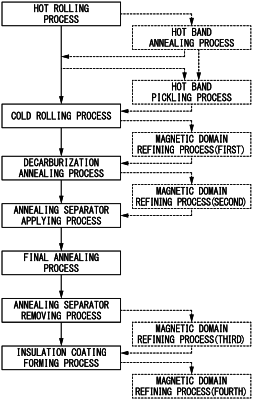| CPC C22C 38/54 (2013.01) [C21D 8/0205 (2013.01); C21D 8/0226 (2013.01); C21D 8/0236 (2013.01); C21D 8/0257 (2013.01); C21D 9/46 (2013.01); C22C 38/001 (2013.01); C22C 38/002 (2013.01); C22C 38/008 (2013.01); C22C 38/42 (2013.01); C22C 38/44 (2013.01); C22C 38/46 (2013.01); C22C 38/48 (2013.01); C22C 38/50 (2013.01); C21D 2201/05 (2013.01)] | 7 Claims |

|
1. A method for producing a grain oriented electrical steel sheet,
the method comprising:
a hot rolling process of hot-rolling a steel piece to obtain a hot rolled steel sheet, the steel piece including, as a chemical composition, by mass %,
0.030 to 0.100% of C,
0.80 to 7.00% of Si,
0.01 to 1.00% of Mn,
0 to 0.060% in total of S and Se,
0.010 to 0.065% of acid soluble Al,
0.004 to 0.012% of N,
0 to 0.30% of Cr,
0 to 0.40% of Cu,
0 to 0.50% of P,
0 to 0.30% of Sn,
0 to 0.30% of Sb,
0 to 1.00% of Ni,
0 to 0.008% of B,
0 to 0.15% of V,
0 to 0.20% of Nb,
0 to 0.10% of Mo,
0 to 0.015% of Ti,
0 to 0.010% of Bi, and
a balance consisting of Fe and impurities;
a cold rolling process of cold-rolling the hot rolled steel sheet to obtain a cold rolled steel sheet;
a decarburization annealing process of decarburization-annealing the cold rolled steel sheet to obtain a decarburization annealed sheet;
an annealing separator applying process of applying and drying an annealing separator including Al2O3 and MgO to the decarburization annealed sheet;
a final annealing process of final-annealing the decarburization annealed sheet after applying the annealing separator to obtain a final annealed sheet;
an annealing separator removing process of removing a redundant annealing separator from a surface of the final annealed sheet; and
an insulation coating forming process of forming an insulation coating on the surface of the final annealed sheet,
wherein, in the decarburization annealing process,
PH2O/PH2 which is an oxidation degree of an atmosphere is 0.18 to 0.80, an annealing temperature is 750 to 900° C., a holding is 10 to 600 seconds, and after decreasing a temperature, an oxide layer of a steel sheet surface is removed by being pickled in a mixed solution of a hydrofluoric acid and a sulfuric acid,
wherein, in the annealing separator applying process,
MgO/(MgO+Al2O3) which is a mass ratio of MgO and Al2O3 is 5 to 50%, and a hydration water is 1.5 mass % or less in the annealing separator,
wherein, in the final annealing process,
an oxidation degree is 0.00010 to 0.2 when an atmosphere includes hydrogen, or a dew point is 0° C. or less when an atmosphere consists of an inert gas without hydrogen,
wherein, in the annealing separator removing process,
the final annealed sheet is water-washed using a solution with an inhibitor which is at least one of a triethanolamine, a rosinamine, or a mercaptan in order to remove the redundant annealing separator from the surface thereof, and an amount of an iron hydroxide and an iron oxide on the surface thereof is controlled to 0.9 g/m2 or less per side, and
wherein, in the insulation coating forming process,
an insulation coating forming solution in which a phosphoric acid and a metal compound are included and in which a mass ratio of the phosphoric acid to the metal compound is 2:1 to 1:2 is applied and is baked at 600 to 1150° C., and after decreasing a temperature, an insulation coating forming solution in which a phosphate and a colloidal silica are included and in which a metal compound is not included is applied and is baked at 600 to 1150° C., in order to form the insulation coating.
|